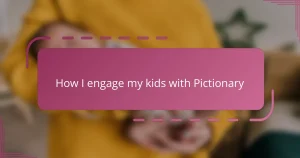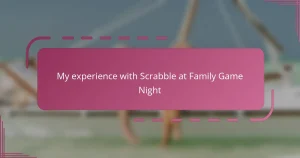Key takeaways
- Play-Doh enhances creativity by allowing children to turn abstract ideas into tangible forms, promoting problem-solving and original thinking.
- It strengthens fine motor skills and offers a platform for emotional expression, helping children process feelings through their creations.
- Play-Doh supports learning by making complex concepts more accessible and encourages sensory exploration, focus, and cognitive skills like planning.
- Incorporating Play-Doh into daily routines and activities fosters creativity, communication, and family bonding through shared play experiences.
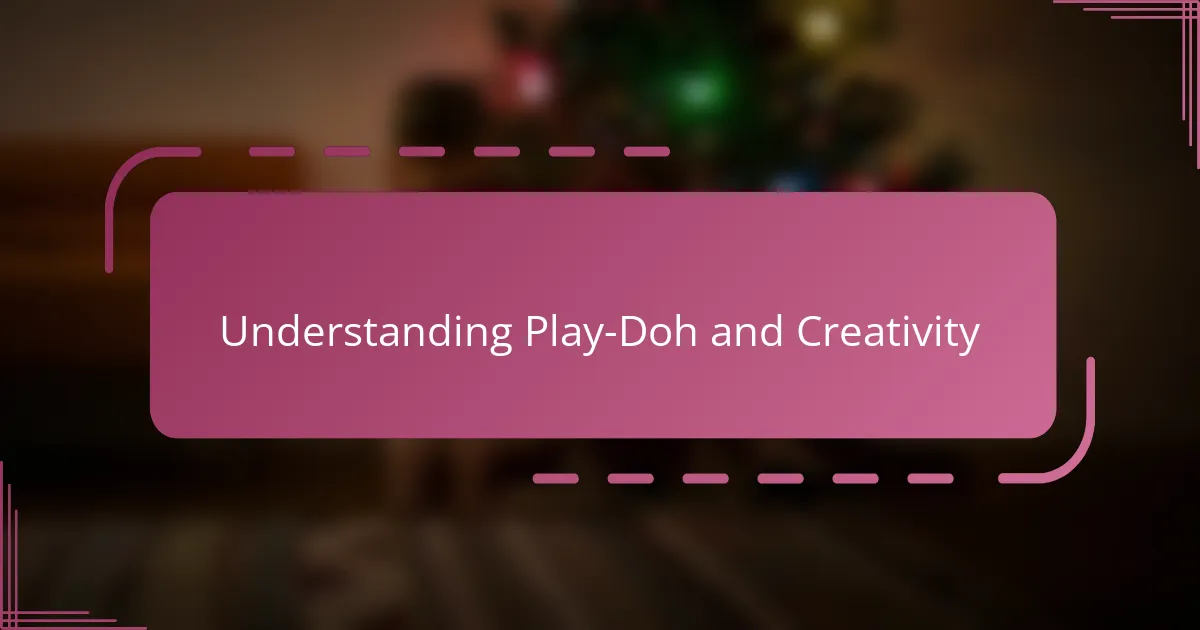
Understanding Play-Doh and Creativity
Play-Doh might seem simple at first glance, but it’s surprisingly powerful when it comes to sparking creativity. I’ve noticed how kids’ imaginations seem to spring to life the moment they squeeze and shape the soft, colorful dough. Have you ever watched a child totally absorbed in molding Play-Doh? There’s something magical in that focused play.
From my experience, the tactile nature of Play-Doh helps children think differently. It turns abstract ideas into something tangible—they can hold their thoughts in their hands, twist them around, and give them form. I believe this hands-on process encourages problem-solving and original thinking more than many digital tools out there.
Isn’t it fascinating how a simple tool like Play-Doh can open so many creative doors? It invites experimentation without the fear of making mistakes because it’s easy to reshape or start fresh. This freedom to explore in a safe space is, in my opinion, a cornerstone of nurturing true creativity in kids.
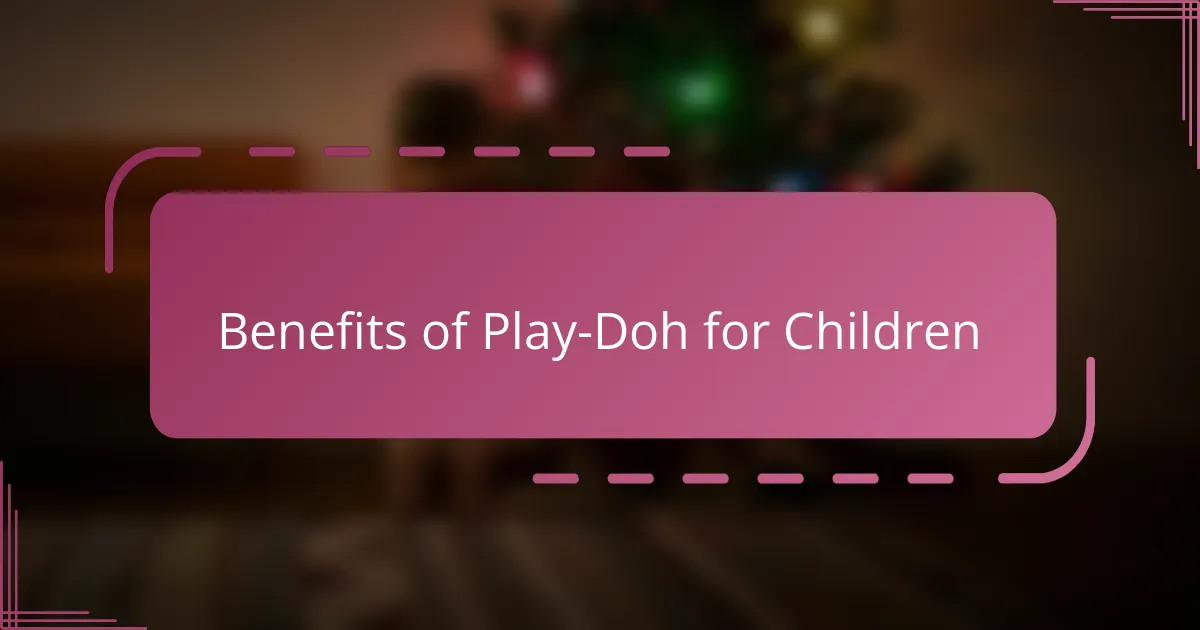
Benefits of Play-Doh for Children
One of the biggest benefits I’ve seen with Play-Doh is how it strengthens children’s fine motor skills. Watching my nephew roll, pinch, and flatten the dough showed me just how these small hand movements translate into better coordination. Isn’t it amazing how something as fun as squishing dough can actually help build the muscles kids need for writing and other daily tasks?
Beyond physical skills, Play-Doh also encourages emotional expression in a way that words sometimes can’t. I remember a little girl at a playdate who used her creations to show how she was feeling that day—a bright sun for happiness, a tangled ball for frustration. It made me realize that Play-Doh can be a gentle outlet for kids to process complex emotions without pressure.
Lastly, there’s the social side of things. When children mold Play-Doh together, I’ve noticed they naturally start collaborating, sharing ideas, and negotiating turns. These moments seem small but are key moments in developing communication and teamwork skills that will benefit them far beyond the playroom. Would any app or game offer that same blend of tactile fun and real-life social learning? I doubt it.
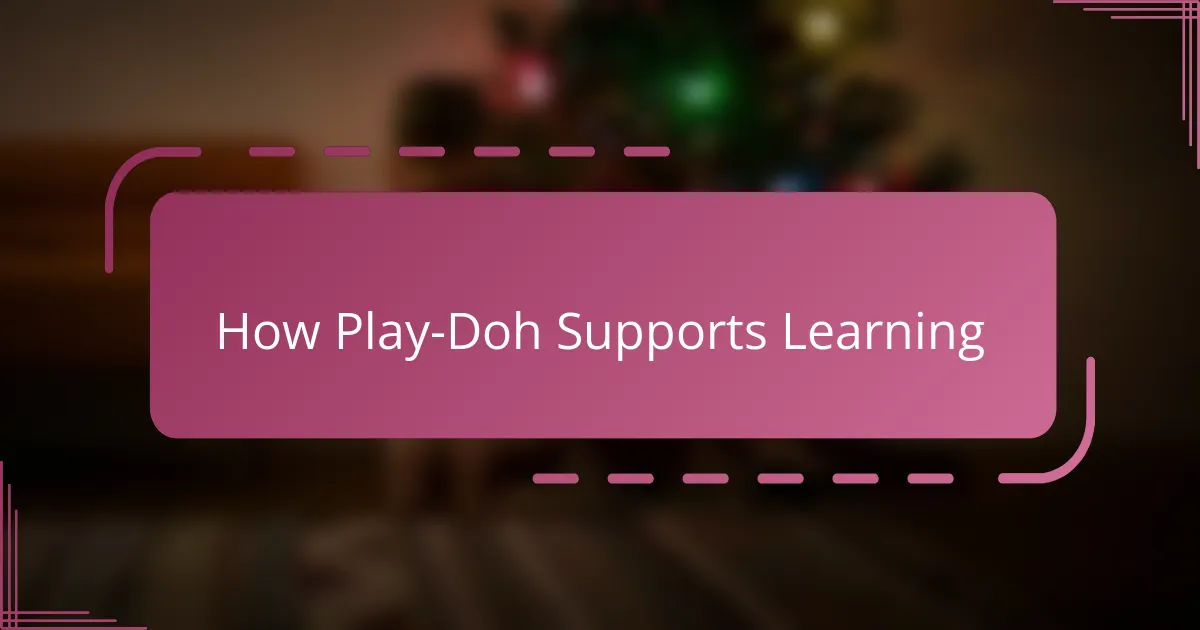
How Play-Doh Supports Learning
I’ve seen firsthand how Play-Doh supports learning by making complex concepts easier to grasp. When my daughter was learning about shapes, she molded triangles and squares with Play-Doh, and suddenly geometry wasn’t just something in a textbook—it became hands-on and clear. Doesn’t that kind of learning stick better than rote memorization?
Another thing I find remarkable is how Play-Doh encourages sensory exploration. The soft, squishy texture invites kids to experiment with pressure and movement, developing their tactile senses. This kind of sensory engagement often helps children stay focused longer and understand their own body awareness.
Play-Doh also quietly boosts cognitive skills like planning and sequencing. I remember my son deciding step-by-step how to build a little Play-Doh house, figuring out what needed to go first and how pieces fit together. Isn’t it amazing how such simple play can teach foundational problem-solving skills?
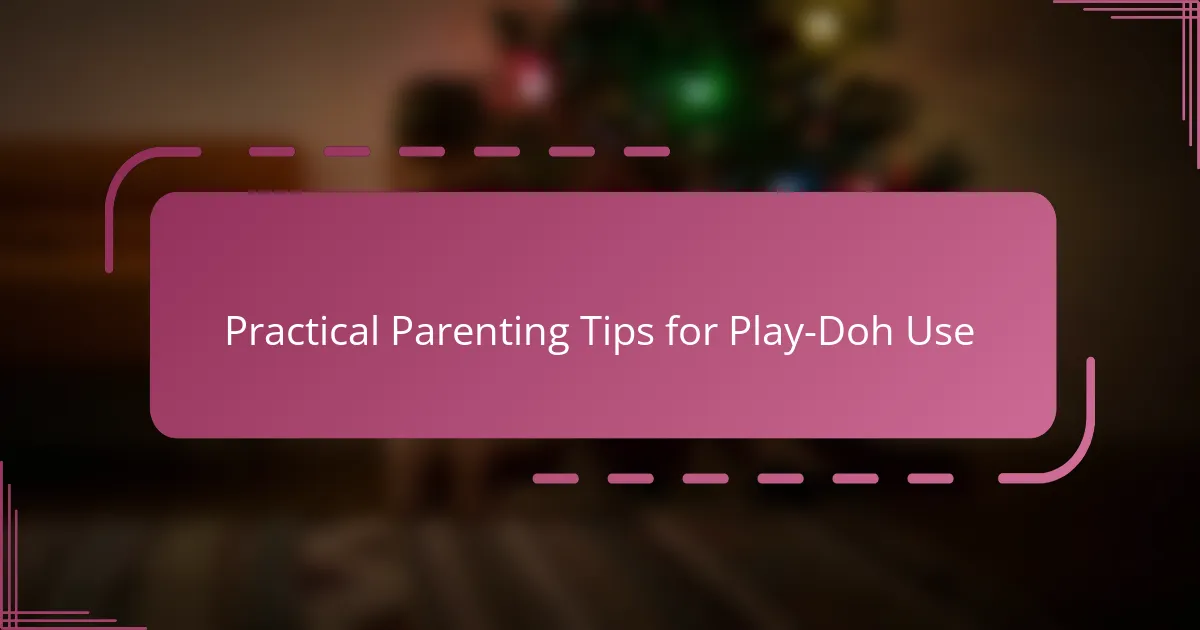
Practical Parenting Tips for Play-Doh Use
One tip I swear by is setting up a dedicated Play-Doh station. Having all the tools, mats, and colors in one place makes clean-up easier and keeps the mess contained. Trust me, when my kids know exactly where to find their creative supplies, they’re more excited to dive in—and I’m less stressed about dough bits hiding under the couch.
I’ve also learned that encouraging choices can make a big difference. Asking questions like, “Which color do you want to use today?” or “What shapes should we try making?” empowers children to take ownership of their play. It’s amazing how a simple prompt can turn a loose session into an engaging creative adventure.
And don’t underestimate the power of modeling creativity yourself. When I join in and start molding alongside my kids, it’s not just about fun—it shows them that their creativity is valued. Have you noticed how children light up when parents get involved? Those moments build confidence and deepen the joy of discovery.
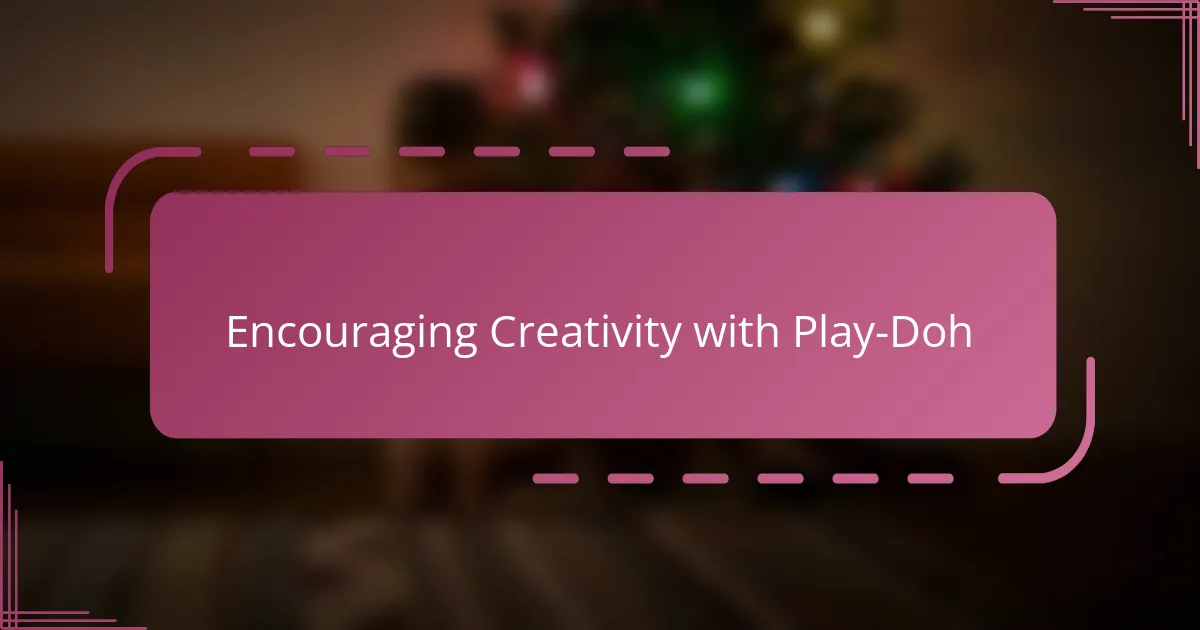
Encouraging Creativity with Play-Doh
When I encourage my kids to create with Play-Doh, I see their confidence bloom as they experiment with shapes and colors without any pressure. Have you noticed how Play-Doh invites endless possibilities, making each creation a unique story? It’s that openness that keeps their imagination flowing freely.
I remember one afternoon when my daughter spent nearly an hour crafting a whole zoo, naming each animal as she squeezed and shaped the dough. That kind of immersive creativity is exactly why I believe Play-Doh is more than a toy—it’s a gateway for children to express themselves fully and learn through play.
Isn’t it wonderful how something so simple can hold a child’s attention while encouraging them to think outside the box? By allowing kids to lead with their ideas, Play-Doh becomes a tool for genuine creative exploration, and I’ve seen firsthand how that empowerment makes all the difference.

My Personal Experience Using Play-Doh
One of my earliest memories using Play-Doh with my kids involved a rainy afternoon when boredom was setting in. We gathered around the kitchen table, and I watched in awe as their frowns slowly turned into bright smiles while their hands shaped colorful creatures and shapes. Have you ever noticed how something so simple can melt away frustration and instantly bring joy?
I also recall a moment when my son tried to recreate his favorite superhero using Play-Doh. He carefully rolled and pinched every detail, showing so much pride in his work. That experience made me realize how Play-Doh doesn’t just spark creativity—it builds patience and focus, qualities I deeply value and hope to nurture in my children.
Sometimes, I join in the play, letting myself get messy alongside them. It’s incredible how it opens up conversations, laughter, and even storytelling. Don’t you find that these shared moments create bonds that last longer than any crafted figure ever could?
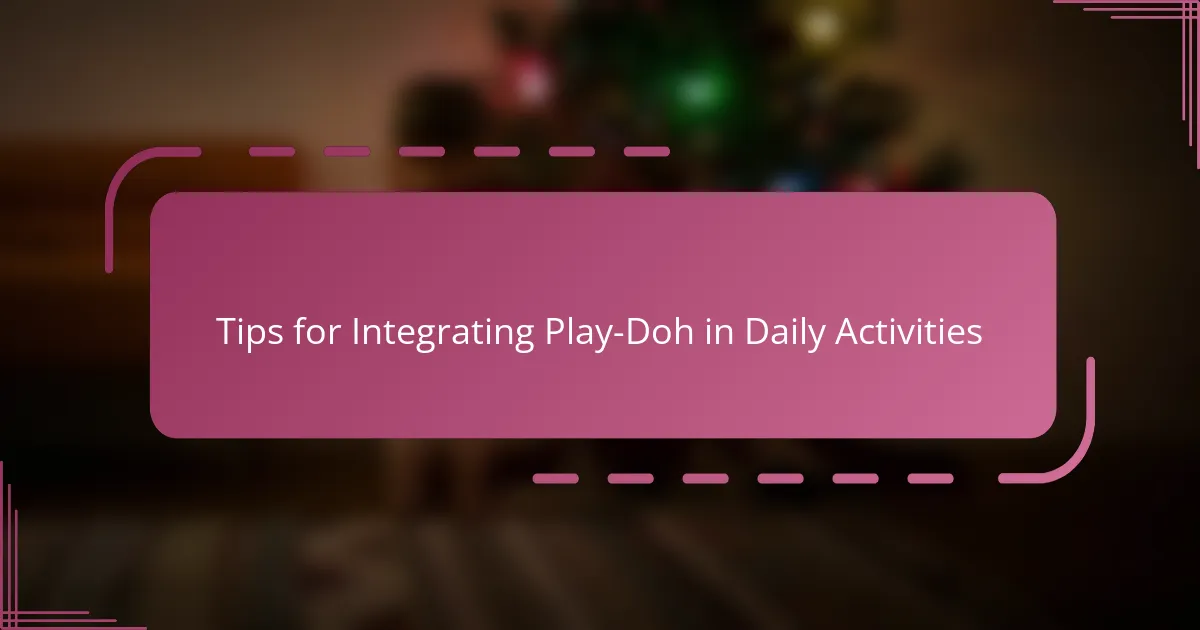
Tips for Integrating Play-Doh in Daily Activities
One way I like to bring Play-Doh into daily routines is by incorporating it into snack time. While waiting for a bite, I encourage my kids to shape their favorite fruits or animals from dough—it turns a simple pause into a creative burst. Have you ever noticed how even a few minutes of playful molding can make the whole day feel more vibrant?
I’ve also found that pairing Play-Doh with storytelling works wonders. Sometimes, I ask my children to craft characters or scenes from a favorite book or their own imagination, which then sparks rich conversations. This makes me wonder—could this little activity be the secret to deepening both creativity and communication in everyday moments?
Finally, I recommend setting little daily challenges, like “Can you make something that starts with the letter ‘B’ today?” It’s amazing how these simple prompts turn routine into a playful game, keeping my kids engaged and thinking creatively without any pressure. Don’t those small sparks of challenge keep playtime fresh and exciting?
